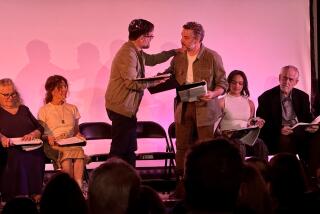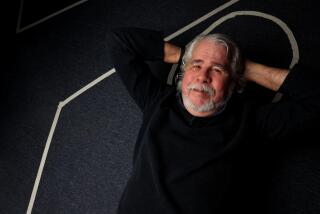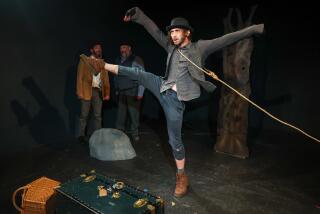STAGE REVIEW : Play Probes Hammett’s Life : Theater: ‘I Can’t Get Started’ probes why America’s most famous detective novelist gave up writing, but does a poor job of reaching conclusions.
SAN DIEGO — First comes a work of fiction. Then come the scholars who examine the person who wrote the fiction. Then, inevitably it seems, comes new fiction that comments on the lives of those who wrote the original fiction.
Sounds complicated? That’s just one spoke of the wheels within wheels that drive Ensemble Arts Theatre’s ambitious production of “I Can’t Get Started,” Declan Hughes’ new play about the writers/lovers Dashiell Hammett and Lillian Hellman.
The show, which also describes a final detective novel Hughes imagines Hammett trying to write, is in its West Coast premiere at the Gaslamp Quarter Theatre Company’s small space through Dec. 7.
The production values of Ensemble Arts, a small, homeless but extremely talented troupe, once again are impeccable. Skillfully directed by artistic director, Glynn Bedington (formerly known as Ginny-Lynn Safford), the show masterfully intercuts the “real” world of Hammett and Hellman with the fictional world of the detective story Hammett is writing.
But the play itself, which contains a cornucopia of possibilities, leads to a buffet of intellectual and emotional conclusions when just one would have been more satisfying.
The play begins with Hammett (Paul Eggington) unable to get started on a new novel (hence the play’s title). It is the beginning of a dry spell that began after he finished “The Thin Man” in 1932 and lasted until his death 29 years later.
Curiously, the dry spell overlaps with Hammett’s relationship with Hellman, which began in 1930, two years before her divorce from playwright Arthur Kober, and lasted until Hammett’s death in 1961. During this same period, she came into her own as a playwright, beginning with “The Children’s Hour” in 1934.
The mystery posed here is why Hammett stopped writing. The clues are dropped throughout the script, many through the characters from a final book the playwright imagines Hammett writing, with the characters acting out a plot with thematic parallels to Hammett’s own life.
Was there a connection between Hammett’s dry spell and his relationship with Hellman (played by Shana Wride)? Did he stop because Hellman’s personality and talent overwhelmed him? Did he stop because he was an alcoholic and in poor health? Did he stop because he came to find increasingly irrelevant the hard-boiled detective style he pioneered with the likes of “The Maltese Falcon” in the face of union struggles and the onset of the era of McCarthy blacklisting?
Unlike a good mystery writer, playwright Hughes never fingers one reason as the culprit, although he seems to stand most strongly behind the idea that Hammett found the simple good woman-bad woman stereotypes he wrote about suddenly unconvincing in the wake of his relationship with a complex, demanding, real-life woman. Still, even his real-life relationship didn’t completely cure him of thinking in such stereotypes, which kept him from finding a fresh form or style for himself.
Despite good, forceful acting by Eggington and Wride, the characterizations of Hammett and Hellman are undercut by the playwright’s own inability to get beyond stereotypes. One minute Hammett and Hellman seem on the road to exploring the complexities of their very human condition, the next, they are shrieking caricatures of a woman who can’t get her man to marry her and a man who thinks that women only really care about sexual prowess.
John Carroll pours on the heat as the fictional detective Daniel Webster. Lisa Moore throws the match that lights the flame as the mysterious, seductive woman in white (and the woman’s equally mysterious, nervous twin brother). Diane Sadak, in multiple roles, brings a deep, sultry voice and shadowy dimension to the woman on the sidelines, Nell Kilcoyne. Bryan Bevell, also in one of multiple parts, is slick and powerful as the businessman/father of those troubling twins.
The production design by Tom Mays, resident assistant scenic designer at the La Jolla Playhouse, also provides an edge to the mystery drama. Mays’ set--gray, black, shadowy and stretching on the diagonal from one end of the Gaslamp space to the other--conjures up a dangerous world that sucks in light like a black hole.
Mays’ lighting plays subtle variations on that black and white theme, as do Janice Benning’s period-perfect costumes--some lacy, some dripping with fur--all slyly inviting. Dan “Pea” Hicks’ sound design builds the tension and Leigh Scarritt’s choreography--ballroom spins by Hammett and Hellman and, later, Webster and his lady--build the romance.
The design team creates some moments that make the little hairs on the back of the neck stick up; they make one wish that the play would better elucidate Hammett as a man who could inspire scenes of such power. The play is complex, hard to follow and often frustrating, but it has a lot to offer. It is a play that leaves you thinking, even though it never answers its own questions.
“I CAN’T GET STARTED”
By Declan Hughes. Director is Glynn Bedington. Production designer is Tom Mays. Costumes by Janice Benning. Sound by Dan “Pea” Hicks. Choreography by Leigh Scarritt. Stage manager is Karin Williams. With Shana Wride, Paul Eggington, John Carroll, Lisa Moore, Bryan Bevell, Diane Sadak and Tim West. Tickets are $14-16. At 8 p.m. Wednesdays-Saturdays through Dec. 7. At 547 Fourth Ave., San Diego, 234-9583.
More to Read
The biggest entertainment stories
Get our big stories about Hollywood, film, television, music, arts, culture and more right in your inbox as soon as they publish.
You may occasionally receive promotional content from the Los Angeles Times.










